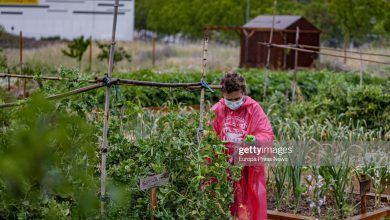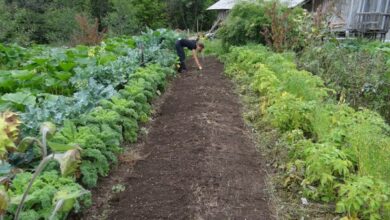Urban gardens in London, a green and edible city
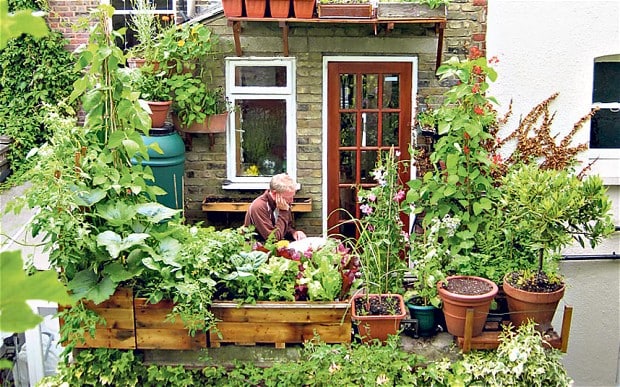
Promised is debt! And after the post Urban Nature in London, what I saw on my trip, I write again to tell you more about the English capital. This time I will talk about urban gardens in London.
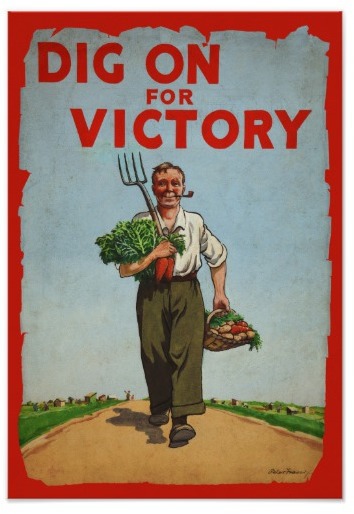
The truth is that I could write dozens of posts about this, since urban gardens in London are everywhere… In this one I will start by giving a general idea of what Urban Agriculture is like and how it has been emerging in this city.
To start… History of urban gardens in London
Well, by history I mean «recent history»… I’m not going to go back to ancient civilizations either
Gardens in the cities more or less as we know them today (small plots where vegetables are grown for home consumption) began to be cultivated and legally regulated in English cities such as London at the end of the 19th century. This was because the Industrial Revolution and the separation between owners and peasant population was causing the increasing impoverishment of the working class and the people who worked in the fields. The solution was to provide small lands (Allotments) to people without many resources so that they could obtain their own food by growing a garden. They were called “orchards for the poor”. All this was regulated by laws such asAllotment Act (1887) or Small Holdings and Allotments Act (1908).
Later, in the first half of the 20th century, the two World Wars also made urban gardens and farms a necessity. They were «subsistence gardens.» They were community gardens that the inhabitants of the city sought to be self-sufficient in order to prioritize imports of food and weapons for the army. And of course… if they didn’t bring food from outside, they had to grow more inside… The government promoted urban agriculture in London and other cities with campaigns like Dig for Victory .
In the second half of the 20th century, many urban gardens on public land ceased to be necessary and disappeared. Some continued to be rented but were also acquiring other more “up-to-date” functions, such as those we saw in the post “ Benefits of urban gardens”: leisure, contact with nature, environmental education, aesthetics, improved nutrition, sustainability, etc.. until reaching the point where London is right now, a city full of urban gardens where anyone can apply to rent a plot to cultivate their own garden or participate in a community garden.
TYPES OF URBAN GARDENS IN LONDON
There are many types of orchards, a single post would not be enough to give details about all of them, but I will try to at least mention them.
1. Public gardens for rent
Hundreds of “allotments” that are distributed throughout the city. There are public gardens in most London boroughs. On the map to the right, the green dots mark the location of the orchards published by the London Assembly in 2006 in a very interesting study on the importance of orchards in the city and their disappearance (you can access the study at this link).

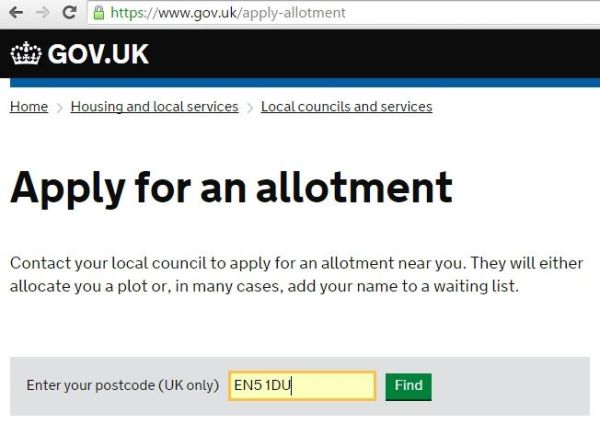
To get to cultivate one of these gardens you have to access the page www.gov.uk/apply-allotment. By entering the postal code as you can see in the image, the application informs us of the orchards in the area and the email addresses, telephone numbers or web pages where you can request a plot to cultivate. The price is usually around 50-60 pounds a year, a symbolic price. The bad thing is that the waiting list is usually long, from a month to a year.
2. Orchards of organic producers
They are orchards cultivated by communities of ecological urban producers. They are like the consumer groups that I already told you about once; various horticulturists or associations that cultivate organic gardens in the city and then sell their organic products directly to the public. An example is Growing Communities, in North East London, on their page you can find details about where the orchards are, who the growers are, where you can buy the products or even the activities and training for volunteers they offer.
3. Community or neighborhood gardens
There are plenty of community gardens in London, and many are part of the Federation of City Farms and Community Gardens.They combine agricultural activity in the orchard with training activities for the unemployed, for schools or for people with problems, and most of them are managed by volunteers (I will tell you about one of them, the Walworth Garden Farm, in the next post).
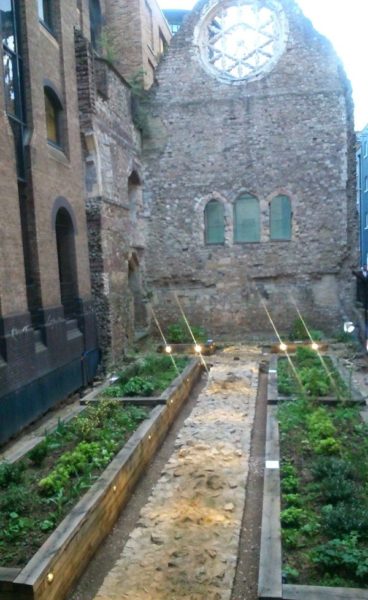
4. Decorative gardens
I also saw some gardens used as an aesthetic tool, like this one that I photographed in some Roman ruins in the middle of «City», near the London Eye.
5. School gardens
How could it be otherwise, school gardens are another type of urban garden in London, and many schools have one as an educational tool and as a way to improve nutrition at school. Just a few examples: Oaklands School Roof Gardens (Bethnal Green) , St Angela’s Ursuline School (Newham), Pooles Park Primary School (Islington), Sir John Cass’s Foundation Primary (Bank) School, Charlton Manor Primary School (Greenwich)…
6. Therapeutic gardens
I also saw several hospitals and health centers that had an orchard, in the post Orchards in hospitals I tell you about its benefits and how was my visit to the Orchard of the St. Charles hospital, in the London neighborhood of Kensington.
Well… maybe I’m getting too long, so I’ll leave the « Community Gardens in London « and some details about the gardens I visited in London for the next post.
I hope you liked it! We await your photos and comments

![Photo of Temperate Continental Climate: [Characteristics, Flora, Fauna and Adaptability]](https://www.complete-gardening.com/wp-content/uploads/2022/08/temperate-continental-climate-characteristics-flora-fauna-and-adaptability-390x220.jpg)
![Photo of La Fitonia: [Characteristics, Planting, Care, Irrigation and Substrate]](https://www.complete-gardening.com/wp-content/uploads/2022/08/la-fitonia-characteristics-planting-care-irrigation-and-substrate-390x220.jpg)
